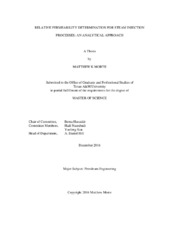| dc.description.abstract | Due to the nature of bitumen and the inability to flow at reservoir conditions, it becomes necessary to alter the original state by imparting heat into the reservoir, thus lowering the viscosity to produce the fluid. The heat introduction is achieved through the utilization of steam assisted gravity drainage (SAGD) as well as solvent steam assisted gravity drainage (S-SAGD). However, the presence of three distinct fluid phases (oil, steam, and water) in the reservoir during steam injection has implications for the effective modeling of the complex fluid dynamics. Inherent complexity as a result of introducing a third phase (steam) in conjunction with temperature dependencies results in the inability to generate a comprehensive three phase relative permeability capable of adequately representing flow in the reservoir at all domains.
In this study, experimental oil recovery data for two SAGD experiments, three S-SAGD experiments and one hot water flood are empirically modelled by manipulating relative permeabilities. Addition of a solvent during the steam injection (S-SAGD) takes advantage of a miscibility component with the bitumen in conjunction with the thermal mechanism of enhanced oil recovery which results in incremental recovery of bitumen along with a minimization of the environmental footprint. The two SAGD experiments are differentiated by different types of clay content while the three S-SAGD experiments vary due to the different solvent and injection strategy utilized during the experiment. The analytical approach implemented allows for the representation of fluid flow in the reservoir by achieving a pseudo-two phase relative permeability that results in comparable performance to the experiments. The assumption of a waterflood through the application of fractional flow theory allowed for the negation of the steam phase in the model and so two-phase flow was established. The sensitivity of the relative permeability curves to temperature change results in the inability to formulate a generic three-phase curve and so the pseudo-two phase curve is valuable for the analysis of the relative permeability behavior for different SAGD scenarios. | en |


